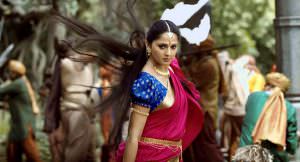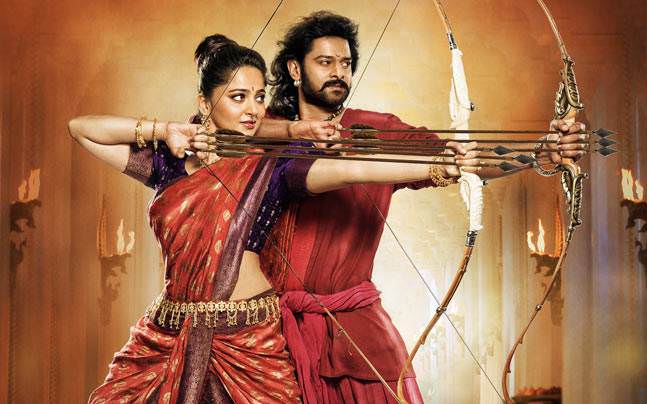After 2 years, finally, we get to know the answer to one of the biggest cliffhangers in the history of Indian cinema; Why did Kattappa kill Baahubali?
Disclaimer: This review contains spoilers.
Baahubali 2: The Conclusion (2017)
Cast: Prabhas, Anushka Shetty, Rana Daggubati, Ramya Krishnan, Sathyaraj, Nasser, Tamannaah
Director: S. S Rajamouli
The magnum opus Baahubali: The Conclusion released this year, with extravagant costumes, exemplary art direction, astounding visual effects and performances. When I went to watch the second part, I expected the same phallocentric and problematic depiction of romance and women being sidelined as they were in the first film. The three important women; Devasena (Anushka Shetty), Sivagami (Ramya Krishnan) and Avantika (Tamannah Bhatia) are strong and determined but they are overshadowed as all the focus is laid on the sibling rivalry and hypermasculinity.
Hypermasculinity is a concept which dominates films thereby subjugating women in films, not just because they’re weaker but due to the social notion that women are meant to be controlled and tamed. Not only is hypermasculinity harmful but it also glorifies violence, and most importantly, it glorifies violence based on caste hierarchies.
We have seen it in Baahubali: The Beginning when Sivudu (Prabhas) stalked and molested Avantika. In terms of exaggerated content, the second film is no less than the first. From Amarendra showing off his “chopping” and archery skills (indirectly) in front of Devasena, to Bijjaladeva (Nasser) punching off a large chunk from a concrete pillar to show that he has “iron fist“. The notion upheld in this film is men who fight and destroy walls like iron are real men.
In that sense, Baahubali :The Conclusion has more over-the-top action sequences that could make you facepalm. Amarendra Baahubali can run as fast as a cheetah, as shown in the initial battle sequences and, Sivudu and Bhalladeva (Rana Daggubati), during a tussle, destroyed a large golden statue by slamming each other’s bodies on the base, and hence cracking it! Baahubali is symbolically shown as demigod or avatar of Lord Vishnu. It was quite clear that the director S.S Rajamouli was targeting the male audience and the contents are created to generate maximum applause.
The movie is entertaining, however it has a wide prospect of analysis, especially from the angle of caste and feminism. Baahubali: The Conslusion, despite having a hero who shares a meal with Kattappa, who is referred to as “Nayya” (dog) several times by the likes of Bijjaladeva and Bhallaladeva, painfully glorifies the caste hierarchy on the basis of lifestyle and skin colour. The Indian film industry, over the years has reiterated caste hierarchy with the likes of “Kapoors” and “Nairs” taking up the spotlight.
Baahubali features fair skinned actors in lead roles. The concept is so heavily embedded in the film that it even has an infamous scene, where Sivudu while molesting Avantika, drags her below the waterfall till she becomes “fair enough”. It is such actions which are etched in the minds of individuals which makes the Indian society obsessed with fairness. Kalakeya and his army are symbolised as the non civilised section and they have “dark” skin. The caste hierarchy reflected in the film is itself based on skin colour where Savarnna is described as “good caste” while Dalits as “lower caste”.
Savarnna caste structure of the Mahishmathi Kingdom constantly remind us of the caste hierarchy with “Kshatriya” dharma in most of the dialogues and slaves being labelled as dogs. It is highlighted even more in Anand Neelankantan novel “Rise of Sivagami”, the prequel to the Baahubali films. The book describes a society where low caste men are unfairly punished and beaten while women are treated as sex slaves. Although being a “Kshatriya”, insinuates being brave and daring in the face of adversity, yet amongst other things it enhances the concept of hypermasculinity in itself.
Kattappa has much better skills but he barely gets the laud he deserves because he is limited to the status of a slave. He has to obey everything the King or Rajyamatha commands, even if it’s against his will because the code of the kingdom includes the necessity of the slaves to follow the King. Slavery is Katappa’s dharma which makes him seem less of a human being and more of a tool to be used by the upper caste for their benefit.
Devasena, despite her courage and audacity, shames the newly chosen commander-in-chief by calling him “Naya” and taunts Sivagami’s silence by saying that it is against her “Kshatriya” dharma. This paticular scene generated a lot of applause from the audience. While the audience focused on Devasena’s courage, the director seemed to have targeted the right crowd- the savarnna, upper caste crowd.
Rajamouli’s comments expressed his casteist point of view when he commented that the Manusmriti believes caste is based on lifestyle and called Dalits “parasites” who depend on others. The Manusmriti expresses that women should be controlled and should be protected by and be dependent on three men in her life; Father, Husband and Son. So going by that logic women are also parasites and hence not worthy of being lauded as expressed through different scenarios within the movie.
Baahubali: The Beginning shows Avantika, a fierce warrior with an aim. But she is molested by Sivudu in order to transform her into being “feminine”. From the perspective of the male audience, a woman’s femininity resides in the clothes she wears, her skin colour and the number of shots of her body. Rajamouli himself explained that the intention of the scene is to portray her femininity.
Personally, I didn’t find Avantika’s warrior image any less feminine, probably different from a woman wearing a saree, but not less feminine. What’s worse is that she gradually falls for him and what’s even worse is that her ambition is averted from her by Sivudu. This is a clear reflection of what happens to most women in our society at some stage in their lives.
The notion upheld in this film is men who fight and destroy walls like iron are real men.
What I had hoped to be redeemed in this film is the fact that society mostly believes that a man’s job cannot be trusted upon women, even women with determination and skills, because women are the weaker sex. Avantika’s character didn’t receive the redemption that she deserved. She was reduced to an extra who just pops up at times with a sword and has no dialogues. I had hoped that she would be portrayed doing something important, something intelligent or tactful which men were shown to be doing.
It was quite evident that Kattappa (Sathyaraj) was narrating Amarendra Baahubali’s words while narrating his and Devsena’s story; “A man who lays his hands on a woman without her consent deserve to have his head chopped off”. Kattappa also asks Sivudu to be like his father. Thus, I hoped that there might be a scene where Sivudu apologises to Avantika for misbehaving with her. But my hopes were quite high, given that we don’t really get to see men apologising to women but women do it multiple times thereby provoking their temper.
Despite all this, there are pro-feminist elements in the film, which are worth mentioning.

Sivagami is the most powerful character. Her word is the law and men follow what she says. She earned that power with her intelligence and charisma. She has the final word in terms of choosing the king and the first film depicts her fighting men who tried to take over the throne and later she occupies her space as the “Rajya Matha” (mother of the state) and breastfeeds both Bhalladeva and Baahubali. No one would question her and she silences “angry men” with just a look, even her treacherous son Bhalladeva.
Sivagami is like the de jure head, someone who has the power but is actually manipulated by patriarchy; by her husband and son, and hence follows their ideas and ideologies. She makes many mistakes but finally, when she realises her mistakes, she tries to redeem them, thereby leading to the iconic scene where she holds Baahubali’s son above the water to save him.
On the scale of justice and righteousness, both Sivagami and Devasena are fighters. Sivagami is a woman who stood up for the kingdom and while Devasena stood up for herself.
Avantika is molested by Sivudu in order to make her more “feminine”.
Had Bhalladeva not existed then we would have seen Sivagami living a happy life with Baahubali and Devasena. Bhalladeva himself was not a bad person initially. But since the beginning his over-ambitious father had been influencing him, leading to jealousy, which lead to his hatred towards his cousin Baahubali. His lust towards Devasena triggered his determination to win over the throne. That’s where things began to fall apart.

Devasena, on the other hand, has moments of her own. She takes over the film with her charisma. Almost every scene with Devasena brings up a feminist argument. The introduction scene of Devasena is similar to Avantika’s. She and her followers are attacked by many armed men. But, she fights them all back bravely. Avantika is painfully objectified when Sivudu molests her, but Devasena’s navel is never important. She is beautiful and graceful. She is feminine but not docile. She is caring but at the same time powerful as she protects her people from being attacked.
Bhalladeva lusts after Devasena and he, after manipulating Sivagami, sends a proposal to Devasena in the form of wealth and sweets. Devasena turns him down, as mere wealth cannot win her heart, there is more to her than wealth.
Devasena remarks on Bhalladeva’s absence during his proposal of marriage to her, “Dress him with the ornaments you send me and get him married to the sword. We will look after him.” This is the scene I completely despise. Why does a feminine warrior who wears jewellery while fighting bandits has to use femininity itself as an insult for a man? Does this not insult womanhood more than a man’s masculinity? When will filmmakers and society at large understand that femininity is not an insult.
both Sivagami and Devasena are fighters. Sivagami stood up for the kingdom and while Devasena stood up for herself.
However, I loved how Devasena was shown as a woman with integrity. She stood her ground and fought back an army of men who tried to attack her. Unlike Sivudu rescuing Avantika, Amarendra teaches Devasena how to shoot three arrows at once and the fight which follows is well choreographed.
The scene where Sivagami says “I gave Bhalla my word to get Devasena married to him”, has Devasena snapping back at her saying that, as an individual she can take her own decisions and Sivagami has no authority to dictate her decision making. She does not let injustice prosper and she is quite capable of defending herself as shown when she attacks the commander-in-chief for falsely framing her.
The movie shows Sivagami and Devasena’s relationship as a typical “saas-bahu” relationship. In general context, the bahus who stand up for themselves and talk back are vilified. But Devasena earns the audience’s respect with her agility.
Saas-bahu situations are usually stereotyped as “A woman is another woman’s worst enemy“. However, in this film, we know it is the result of Bhalladeva’s manipulation and the role of men in terms of pitting women against each other. Amarendra understands this and he goes against his mother to support his wife. He considers supporting his wife his duty and moreover calls out his mother’s lack of understanding along with Bhalladeva’s sadistic lust.
When will filmmakers and society at large understand that femininity is not an insult.
Indian men could learn a thing or two from Amarendra, as men tend to follow their mothers over their wives, in situations where the mother is wrong, because of which women face injustice in her marital house. Despite the depiction of hypermasculinity, Amarendra is portrayed as a caring and compassionate individual. He looks after Sivgami when she is not well and nurses her back to health. His love and care for Devasena is another plus point. In the proposal scene he says, “No matter what happens, I am yours” proving his loyalty to her as opposed to “You are mine” and thereby considering loyalty as the woman’s duty alone.
Amarendra’s compassion and not only his ability to lift trees, earns him popularity amongst the audience. The climax involves a lot of destruction of infrastructure, “flying”, gimmicks and exaggerated fight scenes. But during all this, Sivudu steps aside so as to allow Devasena to have her share of vengeance as a price for the the twenty five years she spent in captivity. Devasena’s expression when she performs the “agnipariksha” will haunt you for some time.
Strong women might be sidelined but their actions and words remain impactful. Baahubali: The Conclusion, therefore, shows radical women of a certain time period and the price they were made to pay for hurting the masculine ego. At the end, justice prevails.
Featured Image Credit: Indiatoday
This article has been updated with reference to the casteist and racial nature of the film.
About the author(s)
Writer.








This article is everything I wanted to say about the movie. Really good one!!
Very interesting points.This movie is poised to collect 1200 crores if you make this article popular and create a negative hype it would help to cross 1500 crores which would be a standard all time record. Thank you?.
Um, not a feminist movie in the slightest. I think you missed the scene where Devasena’s navel is grabbed by her pursuer or that Sivagami holds the power she does because she has crossed the age of sexualization, mothers are revered not lusted after. Women are not exempt from objectification despite being capable, lets also not forget that Devasena couldn’t have been sexualised as much as Avantika because she was a “Kshatriya” princess, so the courtship assumes a different approach in the second movie as compared to the first part.
Rajamouli, the captain has tremendous understanding of the time, space and the sequence. The critique has set the power of sexuality by all means based on the strong hold of patriarchy against the feminist perspective….it makes us feel time and again its a tussle between the men, women and social status. The prevailing power is unbinding and the binding factor evolved the movie into a factual.
1.Kattappa was not required by the kingdom to do so.. it’s their family which follows this…
2.Bahubali / bhallaldeva both were not fair…
3. Kalakeya are non civilized not because they are black but because they are dirty…
Hope you understand difference between a clean negro and a person who looks black Because he hasn’t had bath for several days hasn’t brushed and so on…
4. It’s not to show Avantika that she should be feminine… But to show she shouldn’t be unrealistic…
About showing caste system.. how do you expect the history to be different than what it was???